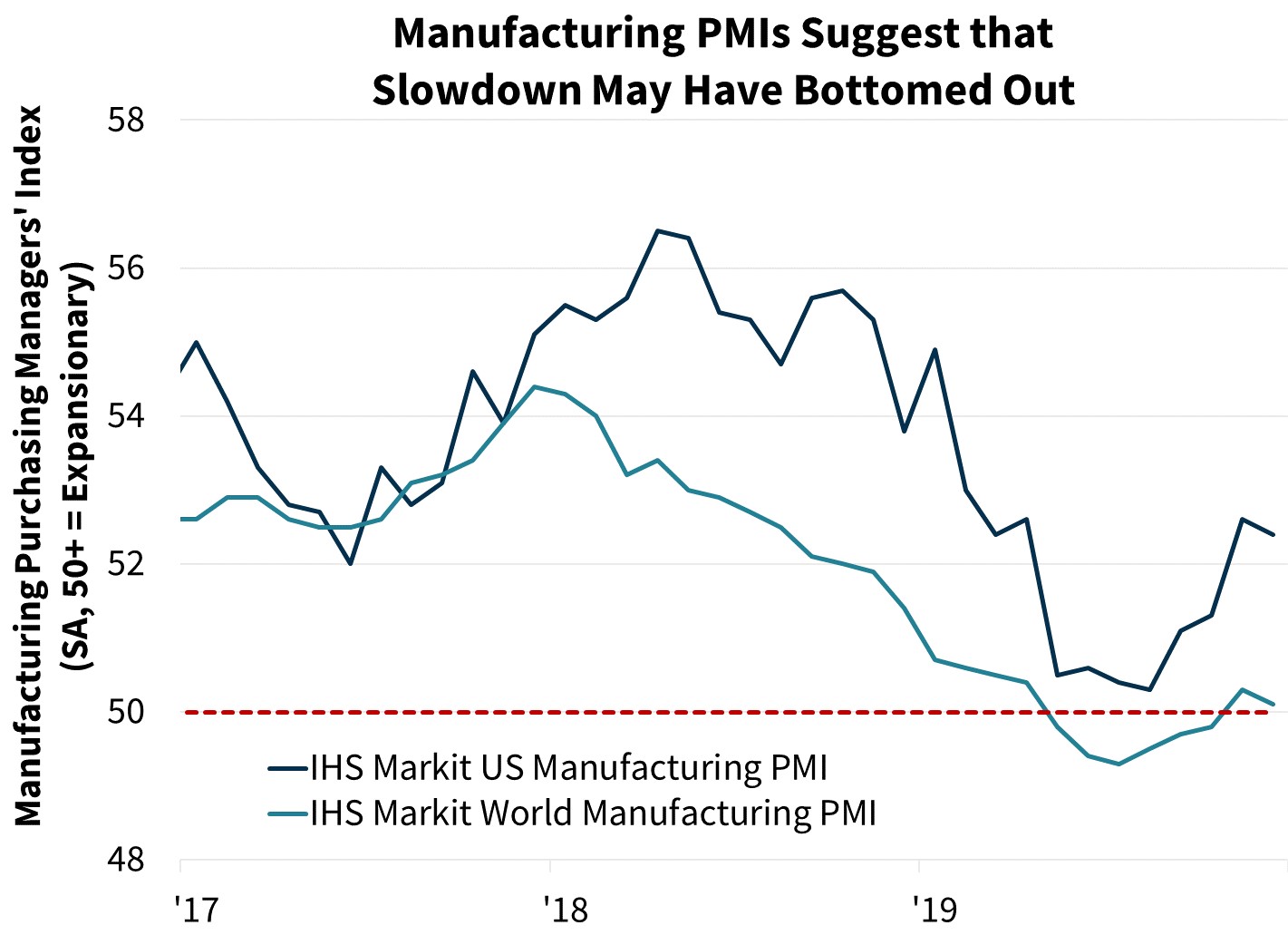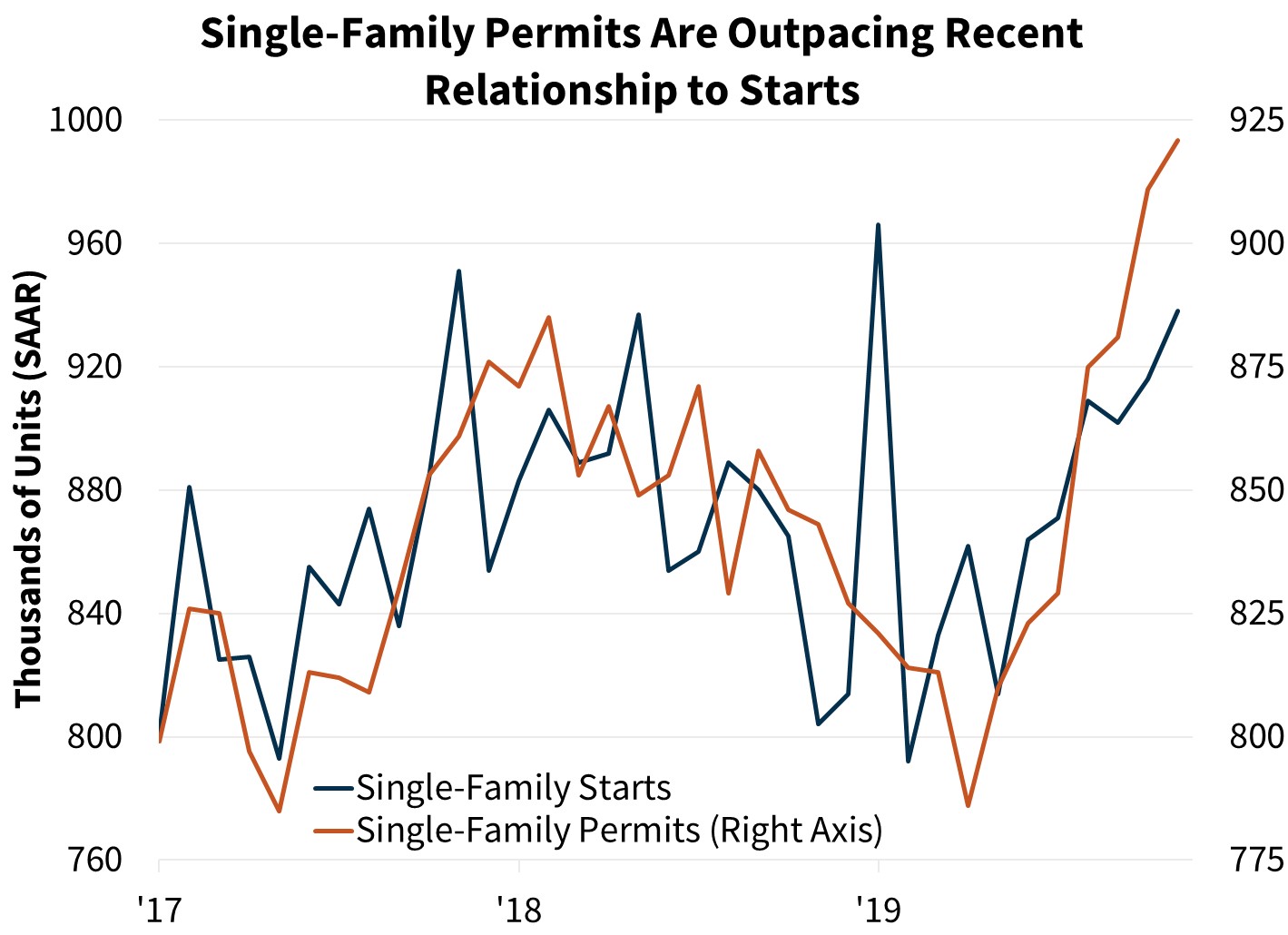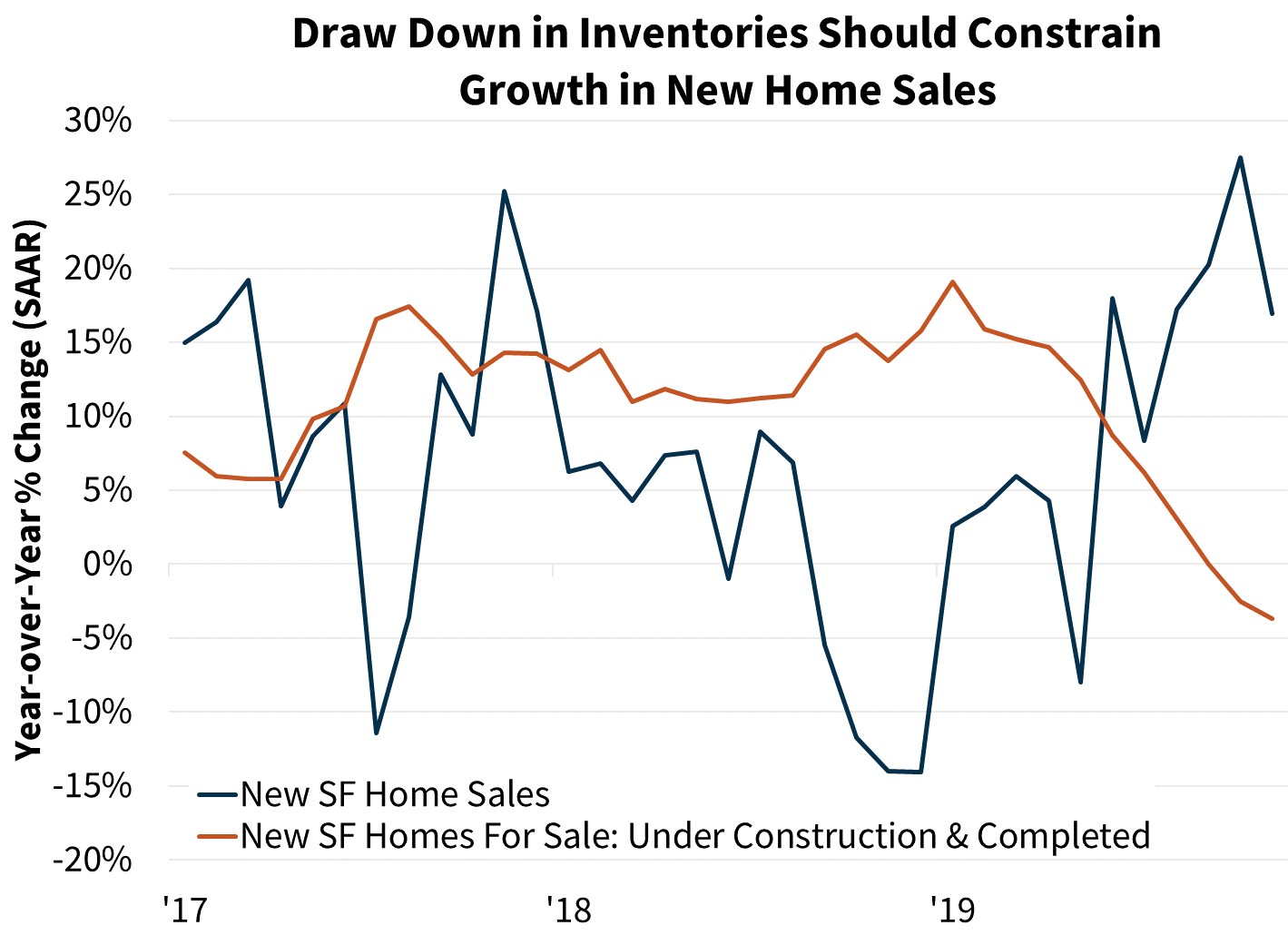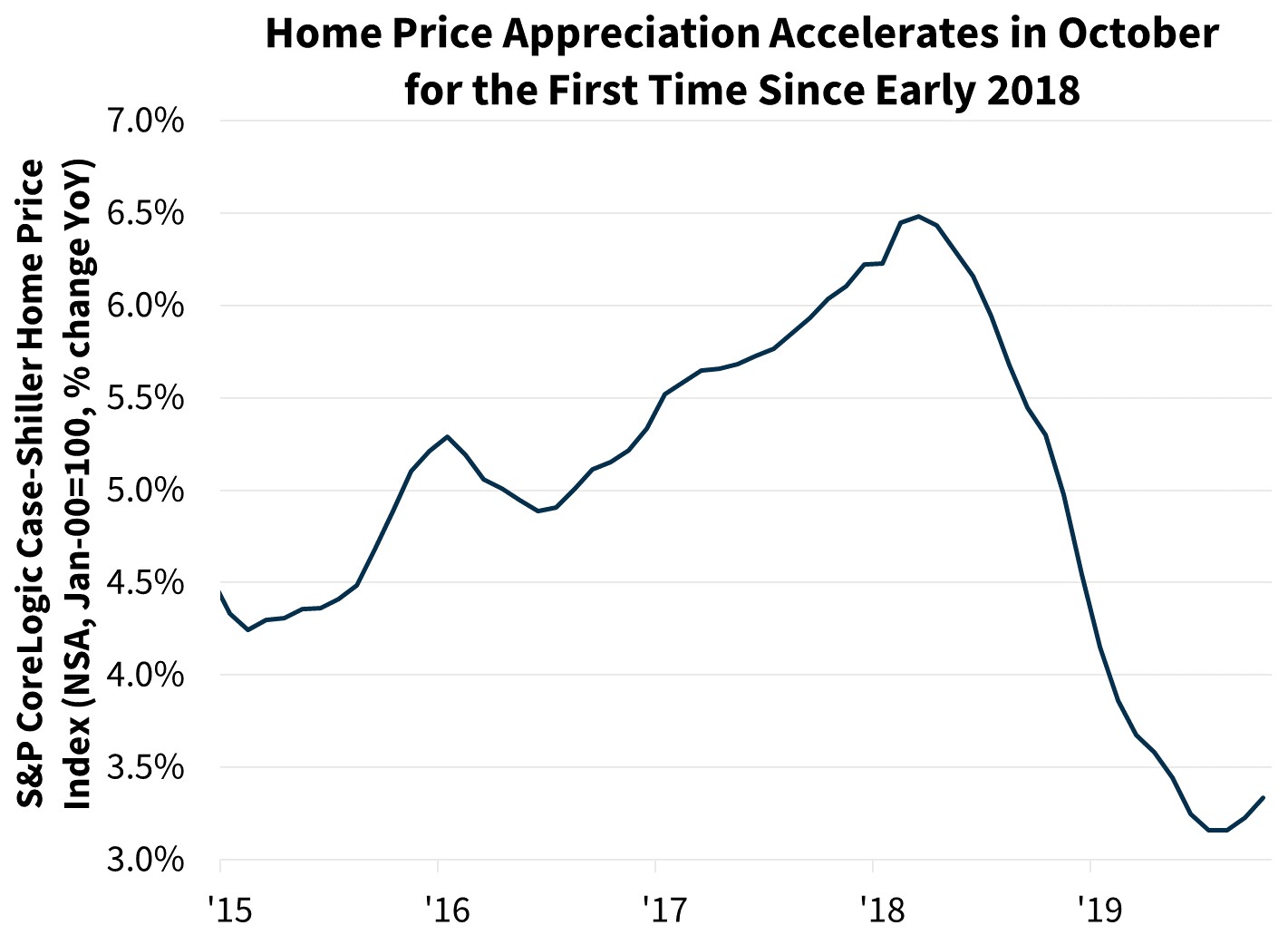A Resilient Economy Overcomes Risks to Drive Housing Economic Developments January 2020
Most of the factors that led us to improve our economic forecast in December remain in place: solid labor markets and consumer balance sheets continue to support growth in personal consumption spending, and an increase in permits validates our view that construction is poised to become a significant contributor to overall economic growth again. Thus, our theme for 2020 is "A Resilient Economy Overcomes Risks to Drive Housing." It should be a good year for housing.
In December we forecast that business fixed investment would turn positive in the fourth quarter of 2019, but we now predict that turn will be deferred until the first quarter of 2020. On the other hand, net exports became an unexpectedly strong contributor to growth in the short term, resulting in little change to our top-line forecast. We now expect that full-year growth in real gross domestic product (GDP) for 2019 will be reported at 2.4 percent versus our previous estimate of 2.3 percent, primarily because of strength in the balance of trade. Other revisions amount to changing our view of the timing of certain developments — particularly in the housing market — rather than the magnitude of those developments. Our 2020 full-year forecast is unchanged at 2.1 percent, though we are now expecting stronger growth at the beginning of this year.
The risks to our forecast are more balanced than they were a month ago but remain skewed slightly to the downside. Three new downside risks have drawn our attention: the geopolitical situation in the Middle East following the strike against an Iranian general, renewed uncertainty as to the magnitude of the downside effect of the 737 MAX grounding following the discovery of unflattering internal emails about the aircraft, and persistent and heightened concerns about the U.S. manufacturing sector based on weakness in the most recent employment report and ISM Manufacturing Index. To the upside, however, we expect global growth to accelerate this year, a reversal from 2019's slowdown, and strong real disposable personal income growth and an elevated savings rate suggest consumers may have more spending power than we previously forecast.
Despite Softer Data to End 2019, 2020 Growth Set to Remain Solid
The December employment report was a minor disappointment — especially compared to the November report — but was not weak enough to generate concern. Growth in nonfarm payrolls was weaker than expected at 145,000, the three-month moving average fell to a still-healthy 184,000, and job gains previously reported for October and November were revised downward by a total of 14,000. On the other hand, the unemployment rate maintained its 50-year low of 3.5 percent as job creation absorbed growth in the labor force, including an increase in the participation rate for prime-age workers to the highest level of the expansion. Moreover, the number of people who are working part-time but would prefer full-time jobs continued its encouraging decline. Average hourly earnings grew by 2.9 percent year over year, a more moderate pace than during the prior year and a half, but still healthy enough to support our forecast for continued strength in consumer spending.
Our November forecast included an improvement in business fixed investment (BFI) predicated primarily upon strength in new orders for durable goods, but data reported since then indicate that our forecast was premature. Durable goods orders, after increasing in October, posted a sharp 2.1 percent decline in November. Furthermore, the jobs report indicated weakness in manufacturing with a decline of 12,000 jobs in December and growth of just 46,000 for all of 2019 versus 264,000 in 2018. The ISM Manufacturing Index reinforced this weakness with a December reading of 47.2, down 0.9 points from its November level and the fifth consecutive month in contraction territory.

Boeing announced in mid-December a halt in production of its 737 MAX aircraft. While the company said that it did not expect any layoffs or furloughs, the revelation of emails reflecting internal concerns about the design of the aircraft — as well as criticism of the regulators whose approval is required — will make it more difficult to restart production. Moreover, the production halt will have wide repercussions, with the largest supplier of parts for the 737 MAX, Spirit AeroSystems, already announcing layoffs and others likely to follow.
In response to this disappointing news about the manufacturing sector, our forecast now reflects no growth in BFI during fourth quarter 2019 and correspondingly smaller growth in full-year 2019 BFI of just 0.3 percent. We judge the risks to our BFI forecast to be solidly weighted to the upside, not only because Boeing may be able to restart production before the U.S. manufacturing supply chain suffers substantial harm, but also because several purchasing manager surveys in the U.S. and other countries have reached expansion territory, indicating that the global manufacturing slowdown may have started to reverse.
The key driver of our forecast for continued near-trend GDP growth is the resilience of consumer spending. This is supported not only by continued current strength in labor markets — including solid employment growth, stable workweeks, and solid wage growth — but also by healthy consumer balance sheets, which would enable consumers to maintain consumption even in the face of minor disruptions in the labor market. Outstanding household debt relative to disposable personal income remains at the lowest level since 2001, and household net worth increased in Q3 2019 for the third straight quarter, according to the Federal Reserve.
Interest Rates to Remain Steady
Neither recent data nor the minutes of the December meeting of the Federal Open Market Committee suggest any basis for changing our view that the target federal funds rate will remain unchanged through the rest of 2020. A key concern remains that inflation has persistently failed to exceed the Fed's "symmetric" target, and the potential damage that could be caused by a significant decline in long-term inflation expectations. Low inflation leads us to believe that the risk of another preemptive cut far exceeds the risk of a hike. As we noted in our previous forecast, we expect that yields will remain stable throughout our forecast horizon, with the 10-year Treasury yield remaining in the 1.9 percent range through late 2020, and mortgage rates to remain within a similarly tight range of approximately 3.7 percent through 2021.
Construction Poised to Grow as Supplies Remain Tight
Housing-related data released over the past month was largely consistent with our previous forecast, but meaningful revisions to prior months' data drove a modest downward revision to our forecast of fourth quarter 2019 growth in real residential fixed investment (RFI). Single-family housing starts rose by a solid 2.4 percent in November to an annualized rate of 938,000, the second highest monthly rate since November 2017 and a continuation of the recent upward trend. Significant downward revisions to the previously reported September and October starts, however, mean that total starts for the fourth quarter will likely be modestly below our previous forecast despite the November strength. We now expect fourth quarter RFI growth to be 4.0 percent annualized compared to our prior forecast of 4.5 percent.

We maintained our view that 2020 will see solid growth in single-family construction. Single-family building permits rose for the seventh straight month in November to a post-recession high. At the same time, permits have outpaced their usual relationship to starts over the past three months and sales of homes not yet started also continue to be above the typical share, suggesting a growing starts backlog. The National Association of Home Builders Housing Market Index jumped to 76 in December, eclipsing the prior cycle peak in 2017. These indicators lead us to believe that growth in housing starts will accelerate in coming months. We now forecast full-year growth in single-family housing starts of 1.1 percent in 2019 (down from our previous forecast of 1.4 percent) and 10.0 percent in 2020 (up from 9.8 percent).
We continue to expect that growth in sales of new homes will be comparatively muted in 2020 relative to 2019. The pace of new home sales increased rapidly over much of 2019 as homebuilders drew down inventories of unsold but previously started homes. As those inventories have become depleted, however, growth in new home sales will likely be constrained until we see the expected acceleration in housing starts. Given our view that some of the growth in starts that we had previously expected in fourth quarter 2019 will now occur in the first half of 2020, we have incorporated modest revisions in our forecasts for new home sales for fourth quarter 2019 (down by 9,000) and in the first quarter and second quarter of 2020 (up by a combined 8,000).

Low mortgage rates and continued job market strength will continue to bolster demand for home purchases. The Fannie Mae Home Purchase Sentiment Index® (HPSI) ticked up in December to 91.7, a level of homebuyer confidence similar to that of late 2017. However, the increase in the supply of existing homes offered for sale that began building in 2018 is now fully exhausted. The number of homes on the market was down 5.7 percent in November from the year prior and sat at the lowest level for that month since the data series began in 1999. Relative to the current pace of sales, the supply of homes for sale fell to 3.7 months. This tightness is limiting potential growth in sales of existing homes despite solid demand factors supporting the housing market. Existing sales declined in November, as we anticipated, by 1.7 percent to an annualized pace of 5.35 million; in addition, however, the data on October sales was revised downward substantially. An increase in the Pending Sales Index in November to the second highest level in nearly two years suggests that a rebound is likely in December, but the magnitude is unlikely to be large enough to offset October's downward revision. We made modest downward revisions in our forecast for existing home sales for fourth quarter 2019 and first quarter 2020, along with equally modest upward revisions in our forecasts for the remainder of 2020 and 2021.
Multifamily housing starts rose 4.9 percent in November, following an upwardly revised 11.8 percent jump in October. Rent appreciation and income growth rates have recently converged, implying that rental property markets are currently balanced, but we expect strength in multifamily construction to persist as solid job growth and demographic trends continue to boost demand, while low interest rates are likely to continue enabling corresponding increases in supply. This view is validated by multifamily construction permits, which have recently been stronger than anticipated. We have revised upward our forecast of multifamily starts to 390,000 in 2019 (up from 381,000 in our previous forecast) and 385,000 in 2020 (up from our previous forecast of 376,000). For more information on multifamily market conditions please see the January 2020 Multifamily Market Commentary.
Faster Home Price Growth Supports Originations
According to Freddie Mac's survey the average rate on 30-year fixed-rate mortgages rose by just 2 basis points to 3.72 percent in December, and we expect mortgage rates to remain stable throughout 2020. Rate stability indicates that we have likely moved past the abnormally large refinancing volumes seen in 2019. Stable low rates would normally support homebuying, but purchase activity is trending firmly sideways, consistent with the sluggish pace of existing homes sales growth due to limited supply.

Strong housing demand, spurred by low interest rates and a solid job market, along with continued tightness in the supply of homes for sale, is helping to bolster home prices. The S&P CoreLogic Case-Shiller National Home Price Index rose 3.3 percent from the year prior in October, the first month of acceleration since early 2018. Similarly, the November reading of the CoreLogic House Price Index showed a 3.7 percent year-over-year gain, up from 3.3 percent in October. We have revised upward our forecast of house price growth in 2020 and 2021, as measured by the FHFA purchase-only index to 4.6 percent and 2.5 percent, respectively. This compares to our previous forecast of 4.1 percent and 2.0 percent.
Our forecast of stronger house price appreciation implies somewhat faster growth in purchase origination volumes than previously expected. We revised upward the growth rate of purchase originations in 2020 and 2021 but these updated actuals led to a modest decline in our 2019 forecast, leaving our anticipated 2020 volumes effectively unchanged after rounding. Purchase mortgage originations for 2019, 2020, and 2021 are expected to be $1.27 trillion, $1.37 trillion, and $1.43 trillion, respectively. Our forecast of refinance originations in 2019 and 2020 were also slightly improved, though we continue to expect a large slowdown this year to $690 billion compared to $918 billion in 2019. We now forecast total mortgage originations of $2.18 trillion in 2019, $2.06 trillion in 2020, and $1.97 trillion in 2021.
Economic & Strategic Research (ESR) Group
(Data effective through January 13, 2020)
For a snapshot of macroeconomic and housing data between the monthly forecasts, please read ESR's Economic and Housing Weekly Notes.
Data source for charts: IHS Markit, JP Morgan Chase, Census Bureau, Standard & Poor’s, CoreLogic, Fannie Mae ESR Group.
Opinions, analyses, estimates, forecasts and other views of Fannie Mae's Economic & Strategic Research (ESR) Group included in these materials should not be construed as indicating Fannie Mae's business prospects or expected results, are based on a number of assumptions, and are subject to change without notice. How this information affects Fannie Mae will depend on many factors. Although the ESR group bases its opinions, analyses, estimates, forecasts and other views on information it considers reliable, it does not guarantee that the information provided in these materials is accurate, current or suitable for any particular purpose. Changes in the assumptions or the information underlying these views could produce materially different results. The analyses, opinions, estimates, forecasts and other views published by the ESR group represent the views of that group as of the date indicated and do not necessarily represent the views of Fannie Mae or its management.
ESR Macroeconomic Forecast Team
- Doug Duncan, SVP and Chief Economist
- Eric Brescia, Economist
- Rebecca Meeker, Financial Economist
- Mark Palim, VP and Deputy Chief Economist
- Nick Embrey, Economist
- Richard Goyette, Business Analyst
